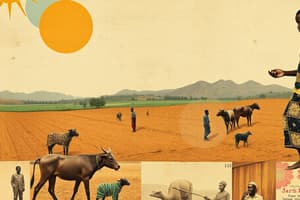Podcast
Questions and Answers
What differentiates Bos indicus from Bos taurus?
What differentiates Bos indicus from Bos taurus?
- Bos indicus are primarily found in temperate zones.
- Bos taurus are known for high adaptability to climatic conditions.
- Bos taurus have noticeable humps.
- Bos indicus are humped cattle found in tropical countries. (correct)
What is a primary purpose of keeping animals in animal husbandry?
What is a primary purpose of keeping animals in animal husbandry?
- Conserving wildlife habitats
- Providing companionship to humans
- Maintaining natural ecosystems
- Producing consumable foods (correct)
Which of the following describes the primary characteristics of pastoralism?
Which of the following describes the primary characteristics of pastoralism?
- Raising crops alongside livestock with seasonal movements.
- Relying solely on agriculture for livelihood.
- Mobility is key, often following seasonal patterns for grazing. (correct)
- Maintaining livestock in permanent settlements.
Which type of farming primarily involves the grazing of livestock on open lands?
Which type of farming primarily involves the grazing of livestock on open lands?
In a mixed farming system, which of the following is primarily practiced?
In a mixed farming system, which of the following is primarily practiced?
What distinguishes transhumance from nomadic pastoralism?
What distinguishes transhumance from nomadic pastoralism?
What is a key difference between nomadic and transhumance pastoralism?
What is a key difference between nomadic and transhumance pastoralism?
What is the primary purpose for raising goats in Ethiopia?
What is the primary purpose for raising goats in Ethiopia?
Which system is characterized by livestock raising that primarily supports agriculture through animal traction?
Which system is characterized by livestock raising that primarily supports agriculture through animal traction?
In which system is livestock integrated with the growing of crops?
In which system is livestock integrated with the growing of crops?
Which classification criterion for goat breeds does NOT apply?
Which classification criterion for goat breeds does NOT apply?
What does intensive farming primarily focus on?
What does intensive farming primarily focus on?
Which of the following is a feature of intensive farming systems?
Which of the following is a feature of intensive farming systems?
Which of the following goat families is found in the smaller Rift Valley of Ethiopia?
Which of the following goat families is found in the smaller Rift Valley of Ethiopia?
What type of pastoralism relies on the seasonal movement of herds to maintain pasture?
What type of pastoralism relies on the seasonal movement of herds to maintain pasture?
Which of the following statements about ranching is accurate?
Which of the following statements about ranching is accurate?
What main characteristic distinguishes agro-pastoral systems from other farming systems?
What main characteristic distinguishes agro-pastoral systems from other farming systems?
Which goat breed is specifically mentioned for its hair production?
Which goat breed is specifically mentioned for its hair production?
Which of the following is a characteristic of pastoralism?
Which of the following is a characteristic of pastoralism?
What type of system is characterized by rotating livestock between pastures?
What type of system is characterized by rotating livestock between pastures?
Which of the following best describes agro-pastoral systems?
Which of the following best describes agro-pastoral systems?
In which type of pastoralism do families move seasonally with their herds in search of pastures?
In which type of pastoralism do families move seasonally with their herds in search of pastures?
The Dromedary camel is characterized by how many humps?
The Dromedary camel is characterized by how many humps?
Which of the following animals is a common type of poultry raised primarily for egg production?
Which of the following animals is a common type of poultry raised primarily for egg production?
Flashcards
Farm animal species
Farm animal species
Animals raised by humans for food or work.
Domestication
Domestication
Converting wild animals to domestic use.
Species
Species
Largest group of animals that can interbreed and produce fertile offspring.
Breed
Breed
Signup and view all the flashcards
Bos indicus
Bos indicus
Signup and view all the flashcards
Bos taurus
Bos taurus
Signup and view all the flashcards
Cattle breeds
Cattle breeds
Signup and view all the flashcards
Ethiopian Cattle Population
Ethiopian Cattle Population
Signup and view all the flashcards
Chicken Digestive System
Chicken Digestive System
Signup and view all the flashcards
Gizzard's Role
Gizzard's Role
Signup and view all the flashcards
Ceca's Function
Ceca's Function
Signup and view all the flashcards
Large Intestine's Purpose
Large Intestine's Purpose
Signup and view all the flashcards
Cloaca's Mixing Role
Cloaca's Mixing Role
Signup and view all the flashcards
Animal Production's Purpose
Animal Production's Purpose
Signup and view all the flashcards
Animal Production's Economic Impact
Animal Production's Economic Impact
Signup and view all the flashcards
Animals' Role in Ethiopian Economy
Animals' Role in Ethiopian Economy
Signup and view all the flashcards
Goat breeds in Ethiopia
Goat breeds in Ethiopia
Signup and view all the flashcards
Angora goat
Angora goat
Signup and view all the flashcards
What are goats raised for?
What are goats raised for?
Signup and view all the flashcards
Camel adaptations
Camel adaptations
Signup and view all the flashcards
Dromedary vs. Bactrian
Dromedary vs. Bactrian
Signup and view all the flashcards
Poultry types
Poultry types
Signup and view all the flashcards
Layers vs. Broilers
Layers vs. Broilers
Signup and view all the flashcards
Pseudo-ruminant
Pseudo-ruminant
Signup and view all the flashcards
Study Notes
Farm Animals in Ethiopia
- Farm animals are raised for human use, either for food or work
- Domestication is the conversion of wild animals to domestic use
- Domesticated animals are selectively bred to live alongside humans
Species vs. Breed
- Species is the largest group of animals capable of interbreeding and producing fertile offspring
- Breed is a specific group of animals within a species that are visibly similar in most characteristics, distinguishing them from other breeds
Farm Animals of Ethiopia
- Ethiopia has a variety of farm animals including: mammals (cattle, sheep, goats, camels, donkeys, horses, mules), avian (chickens, ostriches, turkeys), and honeybees
- Nearly all livestock in Ethiopia are local breeds, some are hybrid, and others are exotic
- Cattle (Bos indicus/Bos taurus): widely distributed, Ethiopia has a high cattle population (75%) concentrated in the Highlands where smallholder mixed crop-livestock production is prevalent
- Bos indicus (humped cattle) are common in tropical countries, while Bos taurus (humped) are found in temperate zones
- Cattle are reared for meat, milk, and as draft animals, their hides are processed into leather, and manure is a by-product
- Cattle are ruminant herbivores and primarily feed on pasture, supplemented with industrial feeds in modern farming
Sheep (Ovis aries)
- Sheep belong to the family Bovidae and genus Ovis
- Over 200 breeds worldwide are recognized
- Sheep are raised for their meat, wool, and skin; some farmers keep sheep for milk
- In Ethiopia, the sheep population is estimated to vary between 23-24 million head, with 70-75% in the highlands
- Different types of sheep in Ethiopia are categorized by origin, tail type, coat type, and function
- Examples include Black head Somali, Adal, Arsi-bale, Tukur, and Horro
Goat (Capra hircus)
- Goats are important for their milk, meat, and skins
- Ethiopia has 17-20 million goats, with a higher population in low lands
- Goats are divided into four families: Nubian, Rift valley, Somali, and Small East African
Camel (Camelus dromedary/Camelus bactrianus)
- Camels are even-toed ungulates
- Two types of camels exist: Dromedary (one hump) and Bactrian (two humps)
- Camels are used as pack or saddle animals, for milk, meat, wool, and hides
Poultry (Gallus gallus domesticus)
- Chicken, ducks, guinea fowl, turkeys, and geese are common types
- Chickens are raised for eggs and meat
- Broilers are raised for meat, while layers are raised for eggs
Ruminants vs. Monogastrics
- Ruminants have a four-chambered stomach (rumen, reticulum, omasum, abomasum) and are primarily herbivores
- Monogastric animals have a single-compartment stomach and can eat a broader range of foods
- Ruminants are better at digesting cellulose, which is found in plants.
Animal Production Systems
- Extensive: Low inputs of labor, fertilizer and capital; animals rely heavily on natural pastures. Productivity is lower.
- Semi-intensive: Intermediate inputs and output; animals are raised in a managed environment.
- Intensive: High inputs and output; animals are often located near urban centers and are fed with high quality feeds, optimized for efficiency.
Animal Production Constraints
- Feed shortage
- Disease and parasites
- Socio-economic constraints; lack of services and facilities
- Inadequate feed supply in quality and quantity is the major constraint.
- Seasonality, and limited awareness of agro-industrial by-products as complementary feeds
Studying That Suits You
Use AI to generate personalized quizzes and flashcards to suit your learning preferences.




